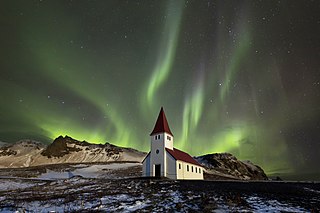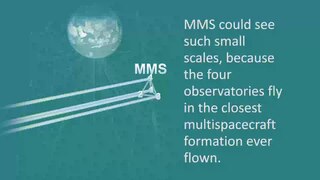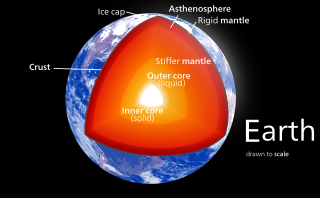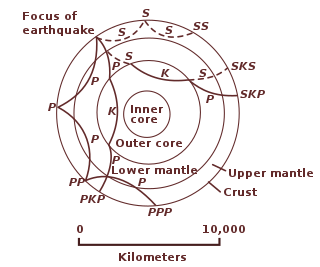Related Research Articles

An aurora , also commonly known as the northern lights or southern lights, is a natural light display in Earth's sky, predominantly seen in high-latitude regions. Auroras display dynamic patterns of brilliant lights that appear as curtains, rays, spirals, or dynamic flickers covering the entire sky.

Geophysics is a subject of natural science concerned with the physical processes and physical properties of the Earth and its surrounding space environment, and the use of quantitative methods for their analysis. Geophysicists, who usually study geophysics, physics, or one of the Earth sciences at the graduate level, complete investigations across a wide range of scientific disciplines. The term geophysics classically refers to solid earth applications: Earth's shape; its gravitational, magnetic fields, and electromagnetic fields ; its internal structure and composition; its dynamics and their surface expression in plate tectonics, the generation of magmas, volcanism and rock formation. However, modern geophysics organizations and pure scientists use a broader definition that includes the water cycle including snow and ice; fluid dynamics of the oceans and the atmosphere; electricity and magnetism in the ionosphere and magnetosphere and solar-terrestrial physics; and analogous problems associated with the Moon and other planets.

Earth's magnetic field, also known as the geomagnetic field, is the magnetic field that extends from Earth's interior out into space, where it interacts with the solar wind, a stream of charged particles emanating from the Sun. The magnetic field is generated by electric currents due to the motion of convection currents of a mixture of molten iron and nickel in Earth's outer core: these convection currents are caused by heat escaping from the core, a natural process called a geodynamo.

A coronal mass ejection (CME) is a significant ejection of magnetic field and accompanying plasma mass from the Sun's corona into the heliosphere. CMEs are often associated with solar flares and other forms of solar activity, but a broadly accepted theoretical understanding of these relationships has not been established.

In plasma physics, an Alfvén wave, named after Hannes Alfvén, is a type of plasma wave in which ions oscillate in response to a restoring force provided by an effective tension on the magnetic field lines.
A geomagnetic reversal is a change in a planet's magnetic field such that the positions of magnetic north and magnetic south are interchanged. The Earth's field has alternated between periods of normal polarity, in which the predominant direction of the field was the same as the present direction, and reverse polarity, in which it was the opposite. These periods are called chrons.

Cluster II is a space mission of the European Space Agency, with NASA participation, to study the Earth's magnetosphere over the course of nearly two solar cycles. The mission is composed of four identical spacecraft flying in a tetrahedral formation. As a replacement for the original Cluster spacecraft which were lost in a launch failure in 1996, the four Cluster II spacecraft were successfully launched in pairs in July and August 2000 onboard two Soyuz-Fregat rockets from Baikonur, Kazakhstan. In February 2011, Cluster II celebrated 10 years of successful scientific operations in space. In February 2021, Cluster II celebrated 20 years of successful scientific operations in space. As of March 2023, its mission has been extended until September 2024. The China National Space Administration/ESA Double Star mission operated alongside Cluster II from 2004 to 2007.

A Birkeland current is a set of electrical currents that flow along geomagnetic field lines connecting the Earth's magnetosphere to the Earth's high latitude ionosphere. In the Earth's magnetosphere, the currents are driven by the solar wind and interplanetary magnetic field and by bulk motions of plasma through the magnetosphere. The strength of the Birkeland currents changes with activity in the magnetosphere. Small scale variations in the upward current sheets accelerate magnetospheric electrons which, when they reach the upper atmosphere, create the Auroras Borealis and Australis. In the high latitude ionosphere, the Birkeland currents close through the region of the auroral electrojet, which flows perpendicular to the local magnetic field in the ionosphere. The Birkeland currents occur in two pairs of field-aligned current sheets. One pair extends from noon through the dusk sector to the midnight sector. The other pair extends from noon through the dawn sector to the midnight sector. The sheet on the high latitude side of the auroral zone is referred to as the Region 1 current sheet and the sheet on the low latitude side is referred to as the Region 2 current sheet.

The earth's inner core is the innermost geologic layer of the planet Earth. It is primarily a solid ball with a radius of about 1,220 km (760 mi), which is about 20% of Earth radius or 70% of the Moon's radius.

Ørsted is an Earth science satellite launched in 1999 to study the Earth's geomagnetic field. It is Denmark's first satellite, named after Hans Christian Ørsted (1777–1851), a Danish physicist and professor at the University of Copenhagen, who discovered electromagnetism in 1820.
Vincent E. Courtillot is an emeritus French geophysicist, prominent among the researchers who are critical of the hypothesis that impact events are a primary cause of mass extinction of life forms on the Earth. He is known for his book "La Vie en catastrophes", translated into English as "Evolutionary catastrophes" (1999).

The World Magnetic Model (WMM) is a large spatial-scale representation of the Earth's magnetic field. It was developed jointly by the US National Geophysical Data Center and the British Geological Survey. The data and updates are issued by the US National Geospatial-Intelligence Agency and the UK Defence Geographic Centre.
Geomagnetic secular variation refers to changes in the Earth's magnetic field on time scales of about a year or more. These changes mostly reflect changes in the Earth's interior, while more rapid changes mostly originate in the ionosphere or magnetosphere.

The following outline is provided as an overview of and topical guide to geophysics:

The history of geomagnetism is concerned with the history of the study of Earth's magnetic field. It encompasses the history of navigation using compasses, studies of the prehistoric magnetic field, and applications to plate tectonics.
Stanislav I. Braginsky was a Research Geophysicist at UCLA. In 1964 he contributed to models of the geodynamo with his theory of the "nearly symmetric dynamo", published 1964. He emigrated from the Soviet Union to the United States in 1988.

Inner core super-rotation is the eastward rotation of the inner core of Earth relative to its mantle, for a net rotation rate that is usually faster than Earth as a whole. A 1995 model of Earth's dynamo predicted super-rotations of up to 3 degrees per year; the following year, this prediction was supported by observed discrepancies in the time that p-waves take to travel through the inner and outer core.
Mioara Mandea is Head "Science Coordination" Department, Strategy Directorate at the Centre National d'Etudes Spatiales. She won the 2018 European Geosciences Union Petrus Peregrinus Medal and has previously served as their General Secretary. She is Officer, National Order of Merit (2023). She is best known for her work on geomagnetic jerks, sub-decadal changes in the Earth's magnetic field.
Jean-Louis Le Mouël is a French geophysicist, physicist emeritus at the Institut de Physique du Globe de Paris (IPGP), which he chaired, and member of the French Academy of sciences since 1988.
Wen Li is a space physicist at Boston University. Her research interests include space plasma waves, Earth's radiation belt physics, solar-wind magnetosphere coupling, energetic particle precipitation, and Jovian magnetosphere and aurora: She is a Fellow of the American Geophysical Union.
References
- 1 2 3 4 De Michelis, Paola; Tozzi, Roberta; Meloni, Antonio (2005). "Geomagnetic jerks: observation and theoretical modeling" (PDF). Memorie della Società Astronomica Italiana. 76: 957–960. Retrieved 16 September 2019.
- ↑ Courtillot, Vincent; Le Mouël, Jean-Louis (10 June 1976). "On the long-period variations of the Earth's magnetic field from 2 months to 20 years". Journal of Geophysical Research. 81 (17): 2941–2950. doi:10.1029/JB081i017p02941.
- ↑ Courtillot, V.; Le Mouël, J. L. (October 1984). "Geomagnetic secular variation impulses". Nature. 311 (5988): 709–716. doi:10.1038/311709a0.
- 1 2 Mandea, Mioara; Bellanger, Eric; Le Mouël, Jean-Louis (December 2000). "A geomagnetic jerk for the end of the 20th century?". Earth and Planetary Science Letters. 183 (3–4): 369–373. doi:10.1016/S0012-821X(00)00284-3.
- 1 2 Olsen, Nils; Mandea, Mioara (March 2007). "Investigation of a secular variation impulse using satellite data: The 2003 geomagnetic jerk". Earth and Planetary Science Letters. 255 (1–2): 94–105. doi:10.1016/j.epsl.2006.12.008.
- ↑ Bloxham, Jeremy; Zatman, Stephen; Dumberry, Mathieu (November 2002). "The origin of geomagnetic jerks". Nature. 420 (6911): 65–68. doi:10.1038/nature01134. PMID 12422214.
- ↑ Aubert, Julien; Finlay, Christopher C. (21 April 2019). "Geomagnetic jerks and rapid hydromagnetic waves focusing at Earth's core surface" (PDF). Nature Geoscience. 12 (5): 393–398. doi:10.1038/s41561-019-0355-1. ISSN 1752-0894.
- ↑ Florindo, Fabio; De Michelis, Paola; Piersanti, Antonio; Boschi, Enzo (2005). "Could the Mw = 9.3 Sumatra earthquake trigger a geomagnetic jerk?". Eos, Transactions American Geophysical Union. 86 (12): 123. doi: 10.1029/2005EO120004 .